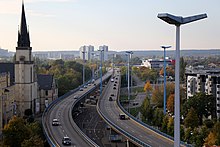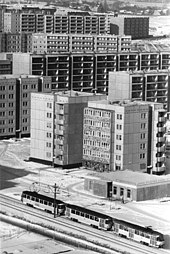Socialist city

Socialist city is a term from planning theory and urban planning history to designate the cultural-genetic city type of socialism . Based on the social model of socialism, certain urban planning ideas were reflected in the cities of the Soviet Union and the Eastern Bloc , which changed during this period. It stands in the tradition of the ideal city .
ideology
Socialist urban planning, like the understanding of planning that was widespread in non-socialist countries in the middle of the 20th century, was based on the principles of modern urban planning , the model of which was laid down in the 1933 Charter of Athens . These included not only the rejection of the dense Wilhelminian style city, but a radical break with all urban planning traditions. This “revolutionary” creation of a completely new order not only corresponded to the numerous idealistic utopias of the interwar period, but was also an expression of the closeness of many protagonists of modernity to socialist ideas.
The transfer of the socialist idea to a city model had two important ideological bases:
- the abolition of private real estate and the resulting phenomena such as the development of land prices according to market laws, property speculation and individual economic investment decisions that should be replaced by planning in favor of the common good, and
- overcoming socio-spatial segregation, for example the existence of “poor” and “rich” districts.
The other guidelines of socialist urban planning largely corresponded to the global understanding of modern planning, such as the creation of green spaces close to residential areas, of "healthy" apartments for all city dwellers, the spatial separation of city functions and the expansion of traffic axes.
One of the specifics, as laid down in the 16 principles of town planning , was, however, the pathetic exaggeration of the new social order, which found expression in the town plan. In contrast to the sober city centers of the West German post-war reconstruction , large parade areas for mass events, representative buildings of the party organs or monumental monuments for socialist “heroes” were important components of a “socialist” city center.
Important characteristics were, on the one hand, a central, wide street for marches and (military) parades, e.g. B. the Karl-Marx-Allee (formerly: Stalinallee) in Berlin as well as an urban height dominant that could testify to the "victoriousness of socialism", for example the Berlin television tower or the high-rise buildings of the University of Leipzig (when completed the tallest building in Germany, today City -Hochhaus ) and Jena (today Jentower ).
Dealing with historical buildings

The model of the “socialist city” is based on a preference for new buildings that are supposed to represent the socialist structure. This was often accompanied by a neglect of the historical building stock. On the one hand, apartments in old buildings were underestimated compared to modern new-build apartments; on the other hand, the historical building stock often represented a time and a model of society that was viewed as having to be overcome. Accordingly, there was no maintenance of the structure of preserved old inner cities, but rather a conscious change. According to Art. 18 of the constitution of the GDR, this was based on a separate concept of culture (that of the "socialist national culture" as one of the "foundations of socialist society"), which also entailed a less considerate approach to - according to another cultural concept - monumental buildings, if they have not "... in the interest of socialist society [...] been declared a monument by the responsible state organs" (§ 3 Monument Preservation Act, see Monument Protection in the GDR ).
Built symbols of the "old order" such as churches ( Leipzig ) or castles ( Berlin ) were sometimes willfully destroyed, new churches were seldom built.
However, the ideological content of urban planning has continued to decline since the 1960s for economic reasons; The neglect of historical building stock or the notorious prefabricated building method had economic rather than political reasons, at least in the later decades: due to the industrial prefabrication of identical residential units, building a new residential area was cheaper than the costly renovation of existing old buildings. In some places that are particularly exposed to tourism, investments were made in the preservation of historical buildings by the 1980s at the latest, even if they were monuments of “bourgeois” culture. Well-known examples were the reconstruction of the Dresden Semperoper or the Berlin Cathedral . In neighboring socialist states such as the ČSSR or Poland , this began even earlier; the reconstruction of bourgeois old towns, such as the Warsaw or Gdansk old town , is particularly well known .
Reconstruction, expansions, start-ups
While the construction of completely new cities began shortly after the October Revolution in the Soviet Union , new foundations in the other socialist countries of Eastern Europe remained an exception. In the war-torn cities of the GDR, Poland and the western USSR, the focus was on reconstruction according to the new principles. From the 1960s onwards, residential towns were created on a smaller scale in newly built industrial centers, but these did not differ significantly from the satellite towns emerging on the outskirts of large cities, which in turn were not specifically Eastern European. Only certain facilities, such as the numerous cultural centers , can be named here as a difference to Western European settlements of the same era.
Three types can therefore be distinguished among socialist cities:
1. Reconstruction of war-torn city centers
Cities with over 200,000 inhabitants

- East Berlin , neoclassical " Stalinallee " (1950s), modernist "central area" between Marx-Engels-Platz and Alexanderplatz (1960s to 80s)
- Warsaw , the metropolis almost completely destroyed in the Second World War, was largely rebuilt according to modern criteria.
- Minsk , the city destroyed in the Second World War, was rebuilt with a center in the style of socialist realism and experienced a population boom through the establishment of a tractor and truck factory.
- Leipzig , ring development (1950s, main plant: Roßplatz ); Karl-Marx-Platz , central university and exhibition towers (1960s / 1970s)
- Dresden , Prager Strasse shopping street as a socialist variant of an inner-city pedestrian zone.
- Chemnitz , meanwhile a listed "socialist city center"
- Magdeburg , rebuilding of the city center along the Breite Weg
- Rostock , Lange Straße (listed)
- Erfurt and Halle were the only two major cities in the GDR that suffered little damage after the war. Here, the expansion of wide street aisles in the inner cities was pushed. In Halle this is the Hochstraße Magistrale with the Riebeckplatz , in Erfurt the Juri-Gagarin-Ring .
Cities with less than 200,000 inhabitants
- Cottbus , redesign of Karl-Liebknecht-Strasse in the 1960s and 1970s and extensive housing construction in connection with the surrounding brown coal combines (1950: 60,000 inhabitants, 1989: 130,000 inhabitants)
- Gera : Demolition of parts of the western city center for the construction of residential high-rise buildings and administrative buildings
- Jena : Demolition of the old town on Eichplatz and construction of the university high-rise
- Dessau , extensive reconstruction of the war-torn city center

- Neubrandenburg , reconstruction of the war-torn town and parallel expansion to the district town (1950: 20,000 inhabitants; 1990: 80,000 inhabitants)
- Frankfurt (Oder) , extensive reconstruction of the war-torn city center
- Suhl is a special case. Although the city was not destroyed in the war, the historic old town was largely demolished around 1970 and replaced by new buildings. Since Suhl was elevated to the status of a district town, housing construction was also pushed there (comparable to Neubrandenburg and Cottbus) in order to increase the population.
- Nordhausen , new construction of the city center after being destroyed in the war
- Halberstadt , new construction of the city center after being destroyed in the war

- Eilenburg , new construction of the city center in the 1950s
- Merseburg , badly damaged in the war. The remaining part of the southern old town was demolished in 1968 and replaced by the socialist reconstruction. The medieval cityscape was completely changed.
2. Satellite cities on the outskirts of large cities
- Prefabricated satellite cities emerged on the edge of all medium-sized and large cities in the GDR. The largest of these satellite cities is located in the north-east of Berlin in the neighboring districts of Hohenschönhausen , Marzahn and Hellersdorf and at times had over 300,000 inhabitants. A list of other satellite cities of the former GDR can be found in the article: Großwohnsiedlung .
3. New industrial and residential cities
Completely newly built work and residential cities (planned cities ), mostly in the vicinity of existing small towns:
- Eisenhüttenstadt (1930: 6,000 inhabitants; 1990: 50,000 inhabitants). Eisenhüttenstadt was founded in 1950 under the name Stalinstadt as the “first socialist city in Germany” near the small town of Fürstenberg / Oder and can be seen as the only real socialist city in Germany.
- Schwedt , Frankfurt / Oder district, GDR, 1960s.
- Halle-Neustadt , Halle district, GDR, 1964
- Wolfen-Nord , Halle district, GDR, for the chemical workers at the Bitterfeld Chemical Combine , the Wolfen Film Factory (ORWO), the Bitterfeld Electrochemical Combine and others. a.
- Hoyerswerda , Cottbus district, GDR, 50s / 60s.
- Nowa Huta near Krakow is the largest new foundation in Eastern Central Europe, the city's major axes come together as a quote from the baroque Versailles on a central square, where there is no castle, but a (never completed) steel mill.
- Expansion of existing small towns for new industrial centers: Lauchhammer (brown coal), Hoyerswerda (1930: 5,000 inhabitants; 1990: 60,000 inhabitants), Weißwasser (1930: 12,000 inhabitants; 1990: 40,000 inhabitants), Leinefelde (1930: 2,000 inhabitants; 1990: 20,000 inhabitants → Eichsfeld plan )
See also
literature
- Frank Betker: The “socialist” city in the GDR: centrally planned, locally designed, built according to the panels . Series of documents and writings of the European Academy Otzenhausen . In: Heiner Timmermann (Hrsg.): That was the GDR - GDR research in the crosshairs of rule, culture, political system, historical research, economy and foreign policy . tape 128 . Lit , Münster 2004, ISBN 978-3-8258-8167-2 , pp. 97-114 .
- Frank Betker: Understanding the necessity. Municipal town planning in the GDR and after the fall of the Wall (1945–1994) . City history. Series: Contributions to urban history and urbanization research. tape 3 . Steiner , Stuttgart 2005, ISBN 978-3-515-08734-6 .
- Thomas M. Bohn: Minsk - model city of socialism. Town planning and urbanization in the Soviet Union after 1945 . (Industrial world. Series of publications of the working group for modern social history 74). Böhlau: Cologne, Weimar, Vienna 2008, ISBN 978-3-412-20071-8 .
- Burkhard Hofmeister: urban geography . The Geographical Seminar. 7th edition. Westermann , Braunschweig 1999, ISBN 978-3-14-160298-2 .
- Henning Büchler, Ingo Zasada: Modern Heritage - Perspectives on how to deal with the preservation of monuments with the evidence of socialist urban development using the example of Aktau - Kazakhstan . ISR gray series . Issue 15. Institute for Urban and Regional Planning TU , Berlin 2008, ISBN 978-3-7983-2092-5 ( full text as PDF download).
- Marina Dmitrieva, Alfrun Kliems (eds.): The Post-Socialist City - Continuity and Change in Urban Space and Imagery , JOVIS Verlag, Berlin 2010, ISBN 978-3-86859-018-0
- Sandra Keltsch: Urban renewal and urban monument preservation in the GDR between 1970 and 1990. Depicted on the development of historic cities in Saxony-Anhalt . Dissertation TU Leipzig, Leipzig 2010 ( digitized version )
Individual evidence
- ↑ Lothar Heinke : Lonely tip: Berlin's most beautiful vantage point turns 40 . In: Der Tagesspiegel , September 27, 2009, p. 13.
- ↑ http://www.mz-web.de/merseburg-querfurt/geschichte-fotoband- shows- merseburg-im-wandel-der-zeiten, 20641044,25520416.html

